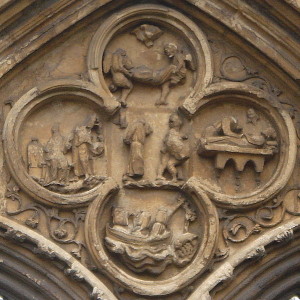In preparation for the joint IES/IHR conference ‘Guthlac of Crowland: Celebrating 1300 Years‘, the IES blog will feature two short posts on the c700 Anglo-Saxon saint.
Reliable information for the life of Guthlac comes from the early Anglo-Saxon period, from a life written in the middle of the eighth century. Felix’s Vita sancti Guthlaci, dedicated to a king of East Anglia, has Mercia as its centre of interest. Guthlac of Crowland is the only Anglo-Saxon saint commemorated in the English vernacular poetry extant from Anglo-Saxon England, in two poems in the Exeter Book (950-970). His vita is the most important historical record extant from pre-Viking Mercia. The Anglo-Saxon Chronicle annal for 714 records the death of Saint Guthlac, an important event in the early history of England. Yet to-day he is almost forgotten. Crowland Abbey was once among the richest fenland monasteries, with impressive buildings, estates, and legends that drew many visitors. All changed suddenly when, on the 4th December 1539, during the reformation of religious institutions in Henry VIII’s England, the abbey was surrendered to the king. The choir of the great fenland abbey, its transepts, central towers and monastic buildings were demolished. There remained the nave and two aisles, to serve as parish church for a single incumbent.
 The conference’s speakers are a mix of established scholars and young graduate students, drawn together with the object of examining the evidence for Guthlac, his life and cult, from many angles. Thus, a wide range of academic fields is represented: history, palaeography and diplomatics, literary studies, musicology, archaeology. We’re delighted that some members of today’s church at Crowland are planning to attend the conference, which will take place on the feast day of the saint and its eve.
The conference’s speakers are a mix of established scholars and young graduate students, drawn together with the object of examining the evidence for Guthlac, his life and cult, from many angles. Thus, a wide range of academic fields is represented: history, palaeography and diplomatics, literary studies, musicology, archaeology. We’re delighted that some members of today’s church at Crowland are planning to attend the conference, which will take place on the feast day of the saint and its eve.
–Alan Thacker, IHR
Guthlac of Crowland: Celebrating 1300 Years will run 10-11 April 2014 in Senate House, University of London. Click here to register for the conference (£65 standard / £45 concessions).
The conference is supported by the Society for the Study of Medieval Languages and Literatures. Image: Detail from Crowland Abbey

